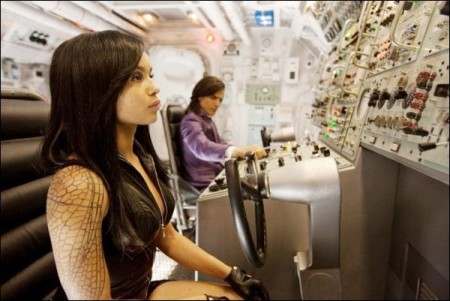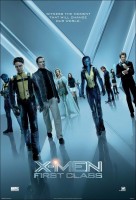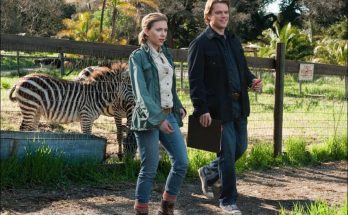Taglines: Witness the origin.
The film is set in the 1960s – the dawn of the Space Age, and a time filled with the hope of JFK’s Camelot. But it was also the height of the Cold War, when escalating tensions between the U.S. and the Soviet Union threatened the entire planet – and when the world discovered the existence of mutants.
It is also during this period that Charles Xavier met Erik Lehnsherr. Before Charles (James McAvoy) and Erik (Michael Fassbender) took the names Professor X and Magneto, they were two young men discovering their powers. Before they were archenemies they were the closest of friends, working together and with other mutants to stop the greatest threat the world has ever known.
Some of these young mutant recruits are fan favorites from the previous X-Men films, while others are classic heroes from the comics but new to the film series. X-MEN: FIRST CLASS provides answers to questions that have long intrigued fans of the movies or comics: How did the X-Men come together? Why is Charles in a wheelchair? Where did the X-Mansion and Cerebro come from?
X-Men: First Class is a superhero film, based on the X-Men characters appearing in Marvel Comics. It is the fifth installment in the X-Men film series and the first in a new trilogy. The film serves as both a prequel and reboot to the X-Men franchise. The film was directed by Matthew Vaughn and produced by Bryan Singer.
The story is set primarily in 1962 during the Cuban Missile Crisis, and focuses on the relationship between Charles Xavier (Professor X) and Erik Lensherr (Magneto), and the origin of their groups—the X-Men and the Brotherhood of Mutants, respectively. The film stars James McAvoy, Michael Fassbender, Rose Byrne, January Jones, Oliver Platt and Kevin Bacon.
Beginnings
X-MEN: FIRST CLASS is a new beginning for the X-Men. The story is by Sheldon Turner, an Academy Award nominee for co-scripting Up in the Air, and Bryan Singer – whose work as the director of the first two films in the series, X-Men and X2: X-Men United, was hailed by critics and audiences around the world for their skillful and seamless blending of drama, action, scale and social-political themes. Singer’s.
X-Men films became a template for the resurgence in comics- to-movie adaptations, and landmarks in the new age of superhero films. Most of X-MEN: FIRST CLASS is set in the 1960s, an apt period for an origins tale because it was during this decade that Marvel Comics editor, head writer and art director Stan Lee, along with Jack Kirby, created the X-Men comics.
The X-Men, like many of their Marvel predecessors, are an unusual heroic group – at times sarcastic, anti-social and clearly flawed, yet sympathetic when battling the demons of their love lives, tackling the traumas of self-esteem, or taking on powerful villains in their universe of special powers. They are the children of the atom, homo superior, and the next link in the chain of evolution. Each mutant was born with a unique genetic mutation, which at puberty manifested itself in extraordinary powers. In a world increasingly filled with hatred, prejudice and fear, they are scientific oddities…freaks of nature…outcasts who are feared and loathed by those who cannot accept their differences.
“The first order of business in conceiving the story,” says Singer, “was figuring out the era in which both Charles and Erik would have met, when they were in their mid-twenties. We decided that would be the early ‘60s – the height of the civil rights movement and the Cold War. Both aspects of that period provided an exciting opportunity to explore events that would shape our modern world.” One of the Cold War’s flashpoints was the Cuban missile crisis, during which the threat of sudden global extinction loomed large, and which provided the ultimate stakes for mutants to reveal themselves to the world and prevent a conflagration that would engulf the planet.
An equally important context for the film is the issue of civil rights – will the mutants be accepted by humanity, or will they be seen as threats to be imprisoned or even eliminated? Should mutants embrace their differences and reign as the planet’s superior beings, or should they become part of the fabric of society? “I’ve always been fascinated by the concept of assimilation versus aggression – and when the civil rights movement of the day becomes the mutant rights movement of tomorrow,” says Singer.
The relationship between Charles and Erik connects to that theme and exemplifies the ideological and philosophical differences of that era. They are essentially cut from the same cloth, and both see mutants as potential subjects of persecution. However, Charles lives to protect those who fear him while Erik lives to destroy them. Each believes his side is right. Neither is willing to compromise. Says director Matthew Vaughn: “Erik is very suspicious of humans, and Charles thinks everything is going to be fine, and that they can trust humans to accept the emerging mutants. Erik replies, ‘They’re going to turn on us and kill us.’ And he’s right.”
Infusing X-MEN: FIRST CLASS with humanistic, character-based elements was another priority for Vaughn and Singer. “The magic of genre films is you can tell stories about the human condition from an unexpected vantage point, dressed up in spectacle and wonder,” notes Singer. “That’s especially important for the X-Men films because that universe presents characters with a lot of depth. The best X-Men stories celebrate that complexity, and that’s what we all wanted for this film.”
“In every film I do,” adds Vaughn, whose credits include the acclaimed independent films Layer Cake and Kick-Ass, “I ask, ‘Where is the human angle? Every character and action beat must have one. If I can slip in something that helps audiences connect with and care about the characters, it will only enhance the experience of watching the movie. If you don’t care about the characters, then what’s the point?
“X-MEN: FIRST CLASS has big ideas and big moments,” Vaughn continues. “We’re not always relying on huge visual effects to make the movie work. The effects support the characters. The film is a great character piece – with some huge action scenes.”
Singer began thinking about an origins story when was directing the first two X-Men pictures. “I would always think about the histories of the characters when telling the actors how to inform their characters’ behavior. So to be able to go back and execute those backstories I had in my imagination was very satisfying.”
One of those actors who had asked Singer about a character history was Patrick Stewart, who portrayed Charles Xavier in the first three X-Men films. “Patrick was wondering about the origins of Charles, and even then I had an idea about it, which was very different from the comics’ version,” Singer recalls. “I explained the comics’ version of the origins, which was set in Tibet and involved an alien agent named Lucifer, and then I explained my ideas. Patrick said, ‘I prefer it your way!’”
Producer Lauren Shuler Donner, who has been with the X-Men film franchise since the beginning, also remembers the origins for X-MEN: FIRST CLASS dating back to the production of the original films. “During the making of X2 we were chatting between scenes about some of our younger cast members, and I said, ‘Wouldn’t it be great to see a young Professor X or Magneto. We should do a film about the X-Men when they were young.’ Everyone went, ‘Yeah, good idea, good idea.’ And we all talked about it for quite a while, and then of course went back to making X2.”
Singer not only co-wrote the story for X-MEN: FIRST CLASS, he joined the project as a producer, along with Shuler Donner and Simon Kinberg, a skilled writer in his own right whose credits include Mr. and Mrs. Smith and the upcoming This Means War. But who would direct? Singer was unavailable due to his commitment to another project, but a chance meeting he had in London with Vaughn led to the latter agreeing to take the reins.
X-MEN: FIRST CLASS is not Vaughn’s first encounter with the film franchise. After making his directorial debut with the acclaimed independent film Layer Cake, Vaughn came close to helming the third film in the X-Men series, X-Men: The Last Stand, before moving on to direct the critically hailed fantasy epic Stardust and the graphic novel adaptation Kick-Ass.
Vaughn says he took on X-MEN: FIRST CLASS because he sparked to Singer’s idea of setting the story during the Cold War. “I was immediately struck by the cleverness of Bryan’s idea, which was an interesting way of integrating the characters into recent history,” Vaughn remembers. Adds the director’s writing partner Jane Goldman: “One of the things that excited us most about the project was the political backdrop – the idea of integrating that aspect with the X-Men backstory really captured our imaginations.” (Ashley Edward Miller & Zack Stentz, a screenwriting duo who recently co-wrote Thor, receive screenplay credit, along with Vaughn & Goldman.)
While expanding upon the story’s humanistic and political themes, Vaughn and Goldman brought yet another intriguing element of that era into the mix. “The film is X-Men meets the Cuban missile crisis meets James Bond,” Vaughn notes. “It has elements of the ‘60s Bond films starring Sean Connery – the coolness, the action, the danger. It’s three genres all mixed together.”
About the Production
Principal photography began in August 2010 at Pinewood Studios in the United Kingdom. Production designer Chris Seagers created more than 80 sets – including 20 complicated composite sets – at Pinewood and on locations throughout the U.K. and the United States.
Seagers’ work is informed by the optimism of the ‘60s. “That era was groundbreaking in terms of design,” explains Seagers. “Everything was new. Color, shape, and modern lightweight materials like plastic burst onto the scene. We were starting to see these new materials in the architecture. Matthew was also very keen to inject some of that James Bond-ian style into the look of the film, while preserving the somewhat darker landscape of the X-Men world.”
To maintain continuity with the previous X-Men films, specific designs were created through a backward engineering process. “We looked at some of the iconic designs of those films, like Cerebro, the X-Jet, Magneto’s helmet, as well as the characters themselves, and asked ourselves what would their prototypes have looked like,” explains visual consultant Russell de Rozario. “We felt a responsibility to make the evolution of the designs credible.”
One of the film’s most eagerly anticipated sets was the X-Jet, built on a stage at Longcross Studios, in Surrey. Based on the XB-70, a prototype long-range, supersonic bomber developed in the U.S. in the late 1950s, the immense structure measured some eighty feet in length. Another iconic location/set is Charles’ mansion, located in Westchester, New York, which will become Xavier’s School for Gifted Youngsters, where mutant children learn to find their place in a society that has shunned them. Finding a house in England to match the mansions from the original films’ Canada location proved to be a considerable challenge, because English mansions are much older than their Canadian counterparts. Eventually the filmmakers decided on Englefield House, a beautiful Tudor mansion in Berkshire with a long and fascinating history of its own, and which offered breathtaking views of the English countryside.
Other principal sets built at Pinewood include the MIB headquarters and a massive submarine. Also at Pinewood, the filmmakers painstakingly reconstructed the concentration camp set utilized in the original X-Men. “It was amazing how perfectly they’ve recreated the set,” Bryan Singer comments. “I thought they had the original dailies up on the monitor while I was watching the scene being shot for X-MEN: FIRST CLASS.”
Then there’s The Hellfire Club, the swinging ‘60s hotspot that serves as headquarters to Sebastian Shaw and his minions. The Hellfire Club scenes encompass a Vegas-style casino entrance (built in the U.S.); on-location filming at London’s Café de Paris, where hundreds of lingerie-clad women served as extras; and a circular set of Shaw’s inner sanctum, built at Pinewood. The club’s bold and bright colors and use of pop art vibrate with the feel and flavor of the 1960s.
Augmenting the film’s international scope, the filmmakers also recreated locations in Argentina, London, Switzerland and Russia. In early December, a reduced unit relocated to the U.S. to shoot the Cuban beach set on Jekyll Island at the southern tip of Georgia.
Legendary visual effects supervisor John Dykstra, who created the magical work on Star Wars Episode IV- A New Hope and Spider-Man, among other notable films, came aboard to bring to life the mutant powers, some of which are yet unseen in the film franchise. “We have some characters new to the X-Men movies, and their powers had to be compelling,” says Dykstra. “There also had to be a link between a mutant’s personality and the nature of his or her power. We wanted the characters and their abilities to be more than just visually powerful; there had to be an intelligence behind their tactics.”
Dykstra appreciated that the X-Men films, particularly this new one, “poke a hole in the notion that having a power is always a positive thing. The X-Men film series treats the mutants like they’re unique, and with that comes a feeling of being a misfit,” he notes.
Dykstra’s digital work is complemented by the special (practical) effects created by Academy Award winner Chris Corbould, whose recent credits include The Dark Knight, Inception and Casino Royale. Corbould’s visually arresting effects in X-MEN: FIRST CLASS can be seen in scenes set at the concentration camp, in the X-Jet (whose 360-degree spirals were perfected in Inception), and in Shaw’s submarine.
Also adding to the film’s visual dazzle is the work of costume designer Sammy Sheldon, who was charged with maintaining the thematic ‘60s-era “cool” and Bond-ian feel. Sheldon’s biggest challenge was developing the X-suits, worn by Charles, Erik and their young recruits during their climactic epic battle against Shaw and Hellfire Club. Vaughn wanted to remain faithful to the first X-Men comic book cover, which saw the mutants dressed in blue and yellow suits. “Matthew and I also had a strong desire to make the suits utilitarian, using 1960s technology,” Sheldon notes. “So it turns out that Kevlar, a bulletproof substance, was developed in the early ’60s – and the material happened to be processed in the color yellow. (Sheldon added blue to the final costumes.)
As post-production work – including Henry Jackman’s score, which includes new “X-Men” and “Magneto” themes – began to wind down, Vaughn took a few minutes to discuss his hopes and expectations for the film once it hits theaters in June. “I think what distinguishes X-MEN: FIRST CLASS from other comic-book films is we have multiple characters,” he points out. “And each of our characters has unique powers, personalities, dramas, ideologies, ethics and relationships – and all that is critical to the X-Men universe.”
X-Men: First Class
Directed by: Matthew Vaughn
Starring: James McAvoy, Michael Fassbender, Rose Byrne, January Jones, Oliver Platt, Kevin Bacon, Morgan Lily, Zoë Kravitz
Screenplay by: Ashley Miller, Zack Stentz
Production Design by: Chris Seagers
Cinematography by: John Mathieson
Film Editing by: Lee Smith
Set Decoration by: Erin Boyd, Sonja Klaus
Costume Design by: Sammy Sheldon
Music by: Henry Jackman, Eddie Hamilton
MPAA Rating: PG-13 for intense sequences of action and violence, some sexual content including brief partial nudity and language.
Studio: 20th Century Fox
Release Date: June 3, 2011
Hits: 78






